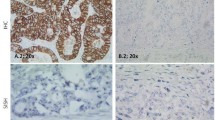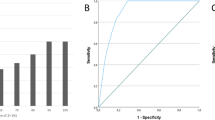Abstract
The high incidence of human epidermal growth factor receptor (HER)2 overexpression on breast and various other cancer cells and the prognostic and potentially predictive value of HER2 render this growth receptor a novel and important therapeutic target. Out of a wide range of assays that have been used in research for the detection of HER2 status, only two techniques are now predominant and readily applicable in the routine clinical pathology laboratory: determination of HER2 overexpression by immunohistochemistry (IHC) and HER2 gene amplification by fluorescence in situ hybridisation (FISH). In a retrospective study on a cohort of 173 archival invasive breast carcinomas a chromogenic in situ hybridisation (CISH) assay for the detection of HER2 amplification was established. Results were compared to HercepTest™, which is the most frequently used method for detecting HER2 alteration. Additionally, HER2 gene copy number was investigated using differential PCR (dPCR) as a testing system. Discrepant cases between CISH and HercepTest™ and all IHC positive cases (2+ and 3+), a total of 42 cases, were analysed with FISH Path Vysion™ (Vysis) assay. HER2 overexpression was found by IHC in 24.3%, HER2 amplification by CISH in 19.1% and by dPCR in 9.2% of the tumours. The overall concordance rate between CISH and IHC was 95.9%, between dPCR and IHC 85% and between CISH and FISH 100%, respectively. Among 25 HercepTest™ positive cases (score 3+) two showed no gene amplification and four out of 13 tumours with score 2+ were negative with CISH and FISH. The current study showed that CISH offers an ideal approach that allows detection of HER2 amplification in the context of morphology, whereas the major drawback of dPCR is the impracticability of tissue differentiation of invasive and non-invasive carcinoma.
Similar content being viewed by others
References
Arnould L, Denoux Y, MacGrogan G, Penault-Llorca F, Fiche M, Treilleux I, Mathieu MC, Vincent-Salomon A, Vilain MO, Couturier J (2003) Agreement between chromogenic in situ hybridisation (CISH) and FISH in the determination of HER2 status in breast cancer. Br J Cancer 88: 1587–1591.
Bartlett JM, Going JJ, Mallon EA, Watters AD, Reeves JR, Stanton P, Richmond J, Donald B, Ferrier R, Cooke, TG (2001) Evaluating HER2 amplication and overexpression in breast cancer. J Pathol 195: 422–428.
Bartlett JM, Mallon E, Cooke T (2003) The clinical evaluation of HER-2 status: which test to use? J Pathol 199: 411–417.
Bieche I, Onody P, Laurendeau I, Olivi M, Vidaud D, Lidereau R, Vidaud M (1999) Real-time reverse transcription-PCR assay for future management of ERBB2-based clinical applications. Clin Chem 45: 1148–1156.
Bilous M, Dowsett M, Hanna W, Isola J, Lebeau A, Moreno A, Penault-Llorca F, Ruschoff J, Tomasic G, Van De Vijver M (2003) Current Perspectives on HER2 testing: A review of national testing guidelines. Mod Pathol 16: 173–182.
Dandachi N, Dietze O, Hauser-Kronberger C (2002) Chromogenic in situ hybridization: a novel approach to a practical and sensitive method for the detection of HER2 oncogene in archival human breast carcinoma. Lab Invest 82: 1007–1014.
Di Leo A, Dowsett M, Horten B, Penault-Llorca F (2002) Current status of HER2 testing. Oncology 63 (Suppl. 1): 25–32.
Dowsett M, Bartlett J, Ellis I, Salter J, Hills M, Mallon E, Watters A, Cooke T, Paish C, Wencyk P, Pinder S (2003) Correla-tion between immunohistochemistry (HercepTest) and fluorescence in situ hybridization (FISH) for HER-2 in 426 breast carcinomas from 37 centres. J Pathol 199: 418–423.
Foy CA, Parkes HC (2001) Emerging homogeneous DNA-based technologies in the clinical laboratory. Clin Chem 47: 990–1000.
Hanna WM, Kahn HJ, Pienkowska M, Blondal J, Seth A, Marks A (2001) Defining a test for HER-2/neu evaluation in breast cancer in the diagnostic setting. Mod Pathol 14: 677–685.
Johnson RC, Ricci A, Jr, Cartun RW, Ackroyd R, Tsongalis GJ (2000) p185HER2 overexpression in human breast cancer using molecular and immunohistochemical methods. Cancer Invest 18: 336–342.
Joensuu H, Isola J, Lundin M, Salminen T, Holli K, Kataja V, Pylkkanen L, Turpeenniemi-Hujanen T, von Smitten K, Lundin J (2003) Amplification of erbB2 and erbB2 expression are superior to estrogen receptor status as risk factors for distant recurrence in pT1N0M0 breast cancer: a nationwide population-based study. Clin Cancer Res 9: 923–930.
Konigshoff M, Wilhelm J, Bohle RM, Pingoud A, Hahn M (2003) HER-2/neu gene copy number quantified by real-time PCR: com-parison of gene amplification, heterozygosity, and immunohisto-chemical status in breast cancer tissue. Clin Chem 49: 219–229.
Kumamoto H, Sasano H, Taniguchi T, Suzuki T, Moriya T, Ichinohasama R (2001) Chromogenic in situ hybridization analysis of HER-2/neu status in breast carcinoma: application in screening of patients for trastuzumab (Herceptin) therapy. Pathol Int 51: 579–584.
Lyon E, Millson A, Lowery MC, Woods R, Wittwer CT (2001) Quantification of HER2/neu gene amplification by competitive pcr using fluorescent melting curve analysis. Clin Chem 47: 844–851.
Millson A, Suli A, Hartung L, Kunitake S, Bennett A, Nordberg MC, Hanna W, Wittwer CT, Seth A, Lyon E (2003) Comparison of two quantitative polymerase chain reaction methods for detect-ing HER2/neu amplification. J Mol Diagn 5: 184–190.
Pauletti G, Godolphin W, Press MF, Slamon DJ (1996) Detection and quantitation of HER-2/neu gene amplification in human breast cancer archival material using fluorescence in situ hybridiza-tion. Oncogene 13: 63–72.
Pegram MD, Pauletti G, Slamon DJ (1998) HER-2/neu as a predic-tive marker of response to breast cancer therapy. Breast Cancer Res Treat 52: 65–77.
Pellegrini C, Falleni M, Marchetti A, Cassani B, Miozzo M, Buttitta F, Roncalli M, Coggi G, Bosari S (2003) HER-2/Neu Alterations in Non-Small Cell Lung Cancer: A Comprehensive Evaluation by Real Time Reverse Transcription-PCR, Fluores-cence in situ Hybridization, and Immunohistochemistry. Clin Can-cer Res 9: 3645–3652.
Press MF, Bernstein L, Thomas PA, Meisner LF, Zhou JY, Ma Y, Hung G, Robinson RA, Harris C, El-Naggar A, Slamon DJ, Phillips RN, Ross JS, Wolman SR, Flom KJ (1997) HER-2/neu gene amplification characterized by fluorescence in situ hybridiza-tion: poor prognosis in node-negative breast carcinomas. J Clin Oncol 15: 2894–2904.
Schnitt SJ, Jacobs TW (2001) Current status of HER2 testing: caught between a rock and a hard place. Am J Clin Pathol 116: 806–810.
Slamon DJ, Clark GM, Wong SG, Levin WJ, Ullrich A, McGuire WL (1987) Human breast cancer: correlation of relapse and sur-vival with amplification of the HER-2/neu oncogene. Science 235: 177–182.
Slamon DJ, Godolphin W, Jones LA, Holt JA, Wong SG, Keith DE, Levin WJ, Stuart SG, Udove J, Ullrich A (1989) Studies of the HER-2/neu proto-oncogene in human breast and ovarian can-cer. Science 244: 707–712.
Tanner M, Gancberg D, Di Leo A, Larsimont D, Rouas G, Piccart MJ, Isola, J (2000) Chromogenic in situ hybridization: a practical alternative for fluorescence in situ hybridization to detect HER-2/ neu oncogene amplification in archival breast cancer samples. Am J Pathol 157: 1467–1472.
Tubbs RR, Pettay JD, Roche PC, Stoler MH, Jenkins RB, Grogan TM (2001) Discrepancies in clinical laboratory testing of eligibility for trastuzumab therapy: apparent immunohistochemical false-positives do not get the message. J Clin Oncol 19: 2714–2721.
Tubbs RR, Skacel M, Pettay J, Powell R, Myles J, Hicks D, Sreenan J, Roche P, Stoler MH, Hainfeld J (2002a). Interobserver interpre-tative reproducibility of GOLDFISH, a first generation gold-facilitated autometallographic bright field in situ hybridization assay for HER-2/neu amplification in invasive mammary carci-noma. Am J Surg Pathol 26: 908–913.
Tubbs RR, Pettay J, Skacel M, Powell R, Stoler M, Roche P, Hainfeld J (2002b) Gold-facilitated in situ hybridization: a bright-field autometallographic alternative to fluorescence in situ hybrid-ization for detection of Her-2/neu gene amplification. Am J Pathol 160: 1589–1595.
Watters AD, Going JJ, Cooke TG, Bartlett JM (2003) Chromosome 17 aneusomy is associated with poor prognostic factors in invasive breast carcinoma. Breast Cancer Res Treat 77: 109–114.
Zhao J, Wu R, Au A, Marquez A, Yu Y, Shi Z (2002) Determina-tion of HER2 Gene Amplification by Chromogenic In Situ Hybridization (CISH) in Archival Breast Carcinoma. Mod Pathol 15: 657–665.
Author information
Authors and Affiliations
Rights and permissions
About this article
Cite this article
Hauser-kronberger, C., Dandachi, N. Comparison of chromogenic in situ hybridization with other methodologies for HER2 status assesment in breast cancer. Histochem J 35, 647–653 (2004). https://doi.org/10.1007/s10735-004-2186-6
Issue Date:
DOI: https://doi.org/10.1007/s10735-004-2186-6




